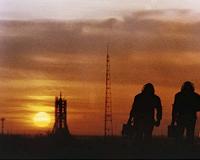 |
Moscow, Russia (RIA Novosti) Jun 03, 2010 Baikonur, the world famous launch pad from where the first Soviet and world cosmonaut Yury Gagarin was sent to space has turned 55 years. It was here that the voice of the Soviet Union's Chief Designer, Sergei Korolev boomed out loud and clear "I am Zarya. Can you hear me?" The decision to establish a testing range for inter-continental ballistic missile and the launching of earth satellites was taken on February 12th 1955. A month earlier, the first construction brigade had arrived in Tura-Tam, accompanied by a strong wind and a minus 35 degree Celsius freezing temperature. The building of the cosmodrome was started under this harsh climatic condition and work was done at a furious pace. The range welcomed the first starting complex in May two years later. But June 2nd 1955, when the original structure of the pad's staff was endorsed, is the official birthday of the cosmodrome. It is to the credit of the starting staff's dedication that Baikonur is today a household word in the world. More than half of all the space launches in the world take place in Baikonur, which is now under the Federal Space Agency, after being stripped of its military component, said Anatoly Perminov, chief of the Space Agency. "Baikonur has a bright future and will be further developed in tandem with Kazakhstan, on whose territory it is situated. We have several joint space plans," disclosed Perminov. The first earth satellite and the first man to go into orbit blasted off from Baikonur, and the first manned space flight involving "Vostok", "Voskhod" and "Soyuz" space ships took off from Baikonur; the orbiting stations, "Salute" and "Mir" were also launched from the cosmodrome and the "Energia" and "Buran" Shuttles were also sent to space from Baikonur. The disappearance of the Soviet Union put Baikonur on Kazakh territory and in 1994 Russia and Kazakhstan signed a lease agreement under which Russia is to pay Kazakhstan 115 million dollars per year for the use of Baikonur. The initial agreement was for a period of 20 years, but in 2004, it was extended to 2050. "Soyuz-TM" ship, and the "Progress-M" automatic one, which carries building materials to the ISS, are also launched from Baikonur. When the American "Shuttles" cease to fly to the ISS, only Russian space ships will be available to carry cosmonauts and astronauts to the ISS. After seeing the "Progress-M" ship, Chief of the US NASA, Charles Bolden declared that the magic of the ship is in its simplicity.
Source: RIA Novosti
Share This Article With Planet Earth
Related Links - Station and More at Roscosmos S.P. Korolev RSC Energia Russian Space News
 Russia Needs Long-Term Space Strategy To Remain Cosmic Superpower
Russia Needs Long-Term Space Strategy To Remain Cosmic SuperpowerWashington DC (RIA Novosti) Jun 03, 2010 Russia needs a long-term space strategy, otherwise it may lose its leadership in the space exploration sphere, Russian cosmonaut and former politician Yury Baturin has said. "Unfortunately, Russia has no long-term space strategy. For some 15 or maybe 20 more years Russia will remain a space superpower, but after this period, Russia will become a second-league space power if a long-term spa ... read more |
|
| The content herein, unless otherwise known to be public domain, are Copyright 1995-2010 - SpaceDaily. AFP and UPI Wire Stories are copyright Agence France-Presse and United Press International. ESA Portal Reports are copyright European Space Agency. All NASA sourced material is public domain. Additional copyrights may apply in whole or part to other bona fide parties. Advertising does not imply endorsement,agreement or approval of any opinions, statements or information provided by SpaceDaily on any Web page published or hosted by SpaceDaily. Privacy Statement |